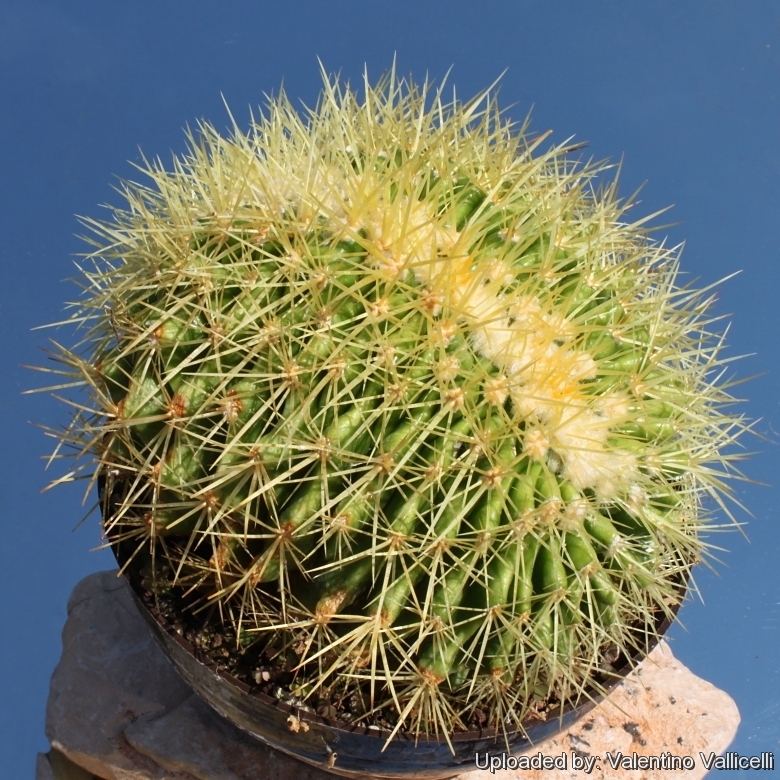
Echinocactus grusonii f. cristatus Photo by: Valentino Vallicelli
Makes huge bright green wavy crest with gold spines.
Origin and Habitat: Garden origin (Nursery produced cultivar)
Synonyms:
See all synonyms of Echinocactus grusonii
Common Names include:
ENGLISH: Crested Mother-in-law's-cushion, Crested Mother-in-law's-seat, Crested Golden Ball Cactus, Golden Barrel Cactus
Description: The typical Echinocactus grusoniiSN|3345]]SN|3345]] is a big globular cactus (commonly known as the "Golden barrel cactus") that is very popular and widely grown for its golden-yellow striking long, golden spines, but this beautiful crested form is still rare in cactus collection. The crested form can also get very big making a spectacular specimen.
Stem: Pale green and heavily ribbed with numerous areoles sprouting radial, yellow spines.
Flowers: Produced from end of spring to summer only on larger mature specimens receiving enough full sun. Flower are diurnal, vivid yellow (4-5 cm wide) and form a circular ring at the top of the plant, but are not very visible being small in relation with the size of the barrel, and lost into the creamy coloured wool at the plant apex.
Subspecies, varieties, forms and cultivars of plants belonging to the Echinocactus grusonii group
 Echinocactus grusonii Hildm.: It produces slowly growing barrel-shaped stem up to 90 cm (180 cm) in height and spread. The stem is pale green and heavily ribbed with very numerous areoles and golden yellow spines.
Echinocactus grusonii Hildm.: It produces slowly growing barrel-shaped stem up to 90 cm (180 cm) in height and spread. The stem is pale green and heavily ribbed with very numerous areoles and golden yellow spines. Echinocactus grusonii var. albispinus Y.Itô: It looks just like a regular "Golden Barrel" but the spines are glassy-white instead of yellow.
Echinocactus grusonii var. albispinus Y.Itô: It looks just like a regular "Golden Barrel" but the spines are glassy-white instead of yellow. Echinocactus grusonii var. albispinus f. cristatus hort.: crested form with spines all white instead of yellow.
Echinocactus grusonii var. albispinus f. cristatus hort.: crested form with spines all white instead of yellow. Echinocactus grusonii f. cristatus hort.: This is a wavy crested form with golden-yellow spines. It can also get very big making a spectacular specimen.
Echinocactus grusonii f. cristatus hort.: This is a wavy crested form with golden-yellow spines. It can also get very big making a spectacular specimen. Echinocactus grusonii var. intermedius hort.: This plant differs from the common Golden Barrel Cactus for the spines that are stout but intermediate in length between the standard from and the short spined type "subinermis" (syn: brevispinus).
Echinocactus grusonii var. intermedius hort.: This plant differs from the common Golden Barrel Cactus for the spines that are stout but intermediate in length between the standard from and the short spined type "subinermis" (syn: brevispinus).- Echinocactus grusonii var. intermedius f. cristatus hort.: Strong crested form with stout spines that are intermediate in length between the standard from and the short spined type "subinermis" (syn. brevispinus).
 Echinocactus grusonii var. intermedius f. variegatus hort.: Yellow and green, variegated plants with short, spines that are intermediate in length between the standard from and the short spined type "subinermis" (syn. brevispinus).
Echinocactus grusonii var. intermedius f. variegatus hort.: Yellow and green, variegated plants with short, spines that are intermediate in length between the standard from and the short spined type "subinermis" (syn. brevispinus). Echinocactus grusonii var. intertextus Y.Itô: (a.k.a "Krauskopf" or "tortulispinus") This plant differs from the common Golden barrel cactus for the spines, that are yellowish-white, sparse, flattish, curved to almost crinkled backward and very irregular, 2 to 6 cm long.
Echinocactus grusonii var. intertextus Y.Itô: (a.k.a "Krauskopf" or "tortulispinus") This plant differs from the common Golden barrel cactus for the spines, that are yellowish-white, sparse, flattish, curved to almost crinkled backward and very irregular, 2 to 6 cm long. Echinocactus grusonii var. intertextus f. cristatus hort.: Crested form with characteristich curved spines, that are flattish, almost crinkled backward and very irregular.
Echinocactus grusonii var. intertextus f. cristatus hort.: Crested form with characteristich curved spines, that are flattish, almost crinkled backward and very irregular. Echinocactus grusonii f. monstruosus cristatus hort.: Crested form of the mostrose cultivar covered by white wool with short yellow spines. The crests are quite unstable
Echinocactus grusonii f. monstruosus cristatus hort.: Crested form of the mostrose cultivar covered by white wool with short yellow spines. The crests are quite unstable Echinocactus grusonii f. monstruosus hort.: Free offsetting small form covered by yellowhish-white wool with short yellow spines. The rib structure is not yet apparent, and they have pronounced tubercles making them look superficially like Mammillarias.
Echinocactus grusonii f. monstruosus hort.: Free offsetting small form covered by yellowhish-white wool with short yellow spines. The rib structure is not yet apparent, and they have pronounced tubercles making them look superficially like Mammillarias. Echinocactus grusonii var. setispinus f. minor cristatus hort.: This is the tiniest crested form. A dwarf form covered by touch friendly spines and looking quite dissimilar to the standard species.
Echinocactus grusonii var. setispinus f. minor cristatus hort.: This is the tiniest crested form. A dwarf form covered by touch friendly spines and looking quite dissimilar to the standard species. Echinocactus grusonii var. setispinus f. minor mostruosus cristatus cv. Scarascia: The plant forms lots of tiny monstrous wooly heads, that time by time begin to crest.
Echinocactus grusonii var. setispinus f. minor mostruosus cristatus cv. Scarascia: The plant forms lots of tiny monstrous wooly heads, that time by time begin to crest. Echinocactus grusonii f. setispinus hort.: This cultivar has very thin acicular spines, that become longer as the plant ages.
Echinocactus grusonii f. setispinus hort.: This cultivar has very thin acicular spines, that become longer as the plant ages. Echinocactus grusonii var. subinermis Y.Itô: (a.k.a. "cv. TOGENASHI KINSHACHI", "inermis" or "brevispinus") This is very short spined mutantant. Except for the spines it is identical in shape and size to the standard species.
Echinocactus grusonii var. subinermis Y.Itô: (a.k.a. "cv. TOGENASHI KINSHACHI", "inermis" or "brevispinus") This is very short spined mutantant. Except for the spines it is identical in shape and size to the standard species. Echinocactus grusonii var. subinermis f. cristata hort.: This is the crested form of the short-spined Golden Barrel. This crest can also get very large
Echinocactus grusonii var. subinermis f. cristata hort.: This is the crested form of the short-spined Golden Barrel. This crest can also get very large
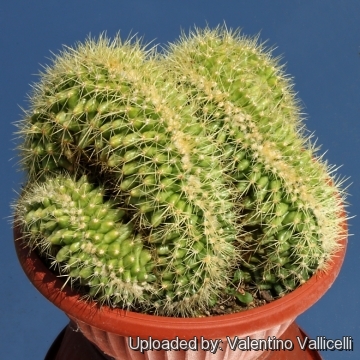 Echinocactus grusonii f. cristatus Photo by: Valentino Vallicelli
Echinocactus grusonii f. cristatus Photo by: Valentino Vallicelli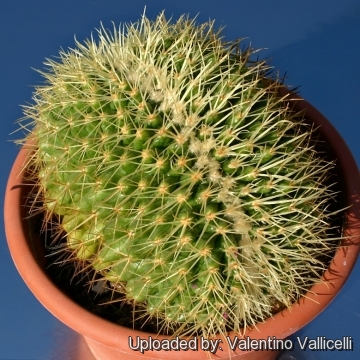 Echinocactus grusonii f. cristatus Photo by: Valentino Vallicelli
Echinocactus grusonii f. cristatus Photo by: Valentino Vallicelli Echinocactus grusonii f. cristatus Photo by: Valentino Vallicelli
Echinocactus grusonii f. cristatus Photo by: Valentino Vallicelli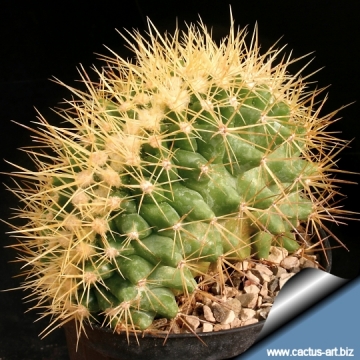 Echinocactus grusonii f. cristatus Photo by: Cactus Art
Echinocactus grusonii f. cristatus Photo by: Cactus Art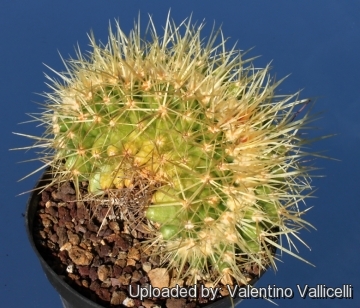 Echinocactus grusonii f. cristatus Photo by: Valentino Vallicelli
Echinocactus grusonii f. cristatus Photo by: Valentino Vallicelli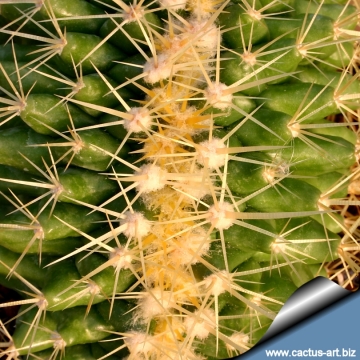 Echinocactus grusonii f. cristatus Photo by: Cactus Art
Echinocactus grusonii f. cristatus Photo by: Cactus Art Echinocactus grusonii f. cristatus Photo by: Cactus Art
Echinocactus grusonii f. cristatus Photo by: Cactus Art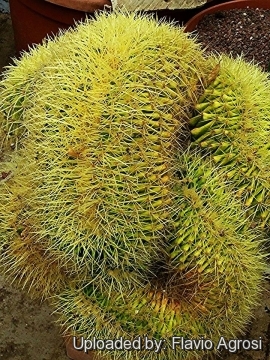 A large specimen at "Rosa Del Deserto" cactus nursery. Photo by: Flavio Agrosi
A large specimen at "Rosa Del Deserto" cactus nursery. Photo by: Flavio AgrosiCultivation and Propagation: It is a fairly easy plant to grow both grafted or in its own roots. During the summer it is best to keep the plants outside where the temperature can rise to over 30 C with no harm to the plant. Furnish good drainage and use a an open and free draining mineral compost that allows therefore roots to breath. They like only a short winter's rest and should be kept almost completely dry during the winter months, If the soil is allowed to be dry for too long root loss could follow but equally the same result would occur if the plants are both wet and cold. From March onwards the plant will begin to grow and watering should be increased gradually until late May when the plant should be in full growth.
Water regularly during the summer so long as the plant pot is allowed to drain and not sit in a tray of water. During hot weather you may need to water the plants more frequently so long as the plant is actively growing. From late September watering should be reduced to force the plant to go in to a state of semi dormancy, by October you should be back in to the winter watering regime.
Need full sun avoiding only the harshest summer sun, if kept too dark they may become overly lush and greener and could be prone to rotting due to over watering.
Feeding may not be necessary at all if the compost is fresh then, feed in summer only if the plant hasn't been repotted recently. Do not feed the plants from September onwards as this can cause lush growth which can be fatal during the darker cold months. Grown specimens resist to -4°C for a short time, but it is best to keep above 5° C to avoid ugly spots on the plant epidermis. Prefers a position in full sun, which will help to maintain the lustre of the spines. Besides, it performs wonderfully in containers, Container media should be coarse as well.
Propagation: From cuttings or grafting on a large strong under-stock.


















